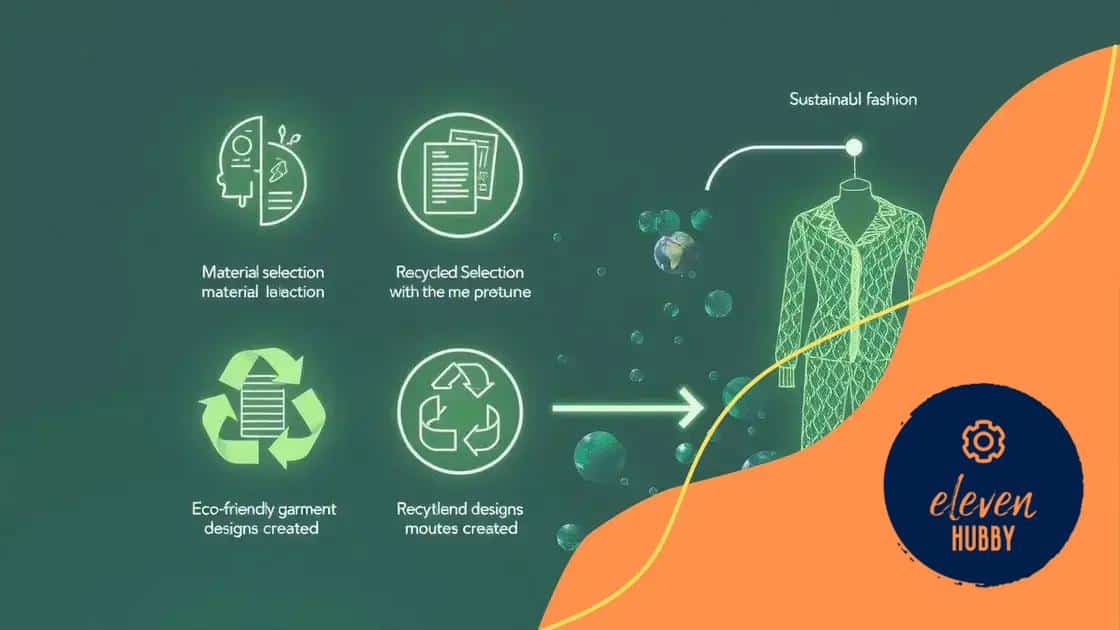How AI is transforming the fashion industry

AI is transforming the fashion industry by enhancing creativity, improving sustainability, and personalizing customer experiences, while also presenting challenges such as data privacy and integration with existing processes.
How AI is transforming the fashion industry is a fascinating journey that reshapes our understanding of style and innovation. Ever wondered how technology could redefine your wardrobe? Let’s dive in and explore this intriguing frontier.
Understanding AI’s role in fashion
Understanding AI’s role in fashion is essential to grasp how technology is changing this vibrant industry. As AI continues to grow, its influence on fashion becomes more significant, impacting everything from design to customer experience.
Enhancing Design Processes
AI assists designers by analyzing trends and generating innovative ideas.
- Artificial intelligence can predict upcoming fashion trends based on current data.
- AI tools help in creating unique patterns and designs.
- These technologies can also suggest improvements for existing collections.
This allows designers to focus more on creativity instead of repetitive tasks. Moreover, AI can simulate fabrics and colors, providing designers with a clearer vision of their creations before physical samples are made.
Improving Customer Experience
In retail, AI enhances how consumers interact with brands. With recommendation systems driven by AI, customers receive personalized shopping experiences tailored to their preferences.
- Tailored product suggestions improve customer satisfaction.
- Chatbots provide instant assistance, improving service.
- Virtual fitting rooms use AI to help shoppers try on clothes online.
These features not only engage shoppers but also streamline the purchasing process, making it easier and more enjoyable.
The integration of AI in supply chain management also optimizes inventory levels, ensuring products are available when needed without excess stock. This leads to both cost savings and reduced waste.
As we delve deeper into the connection between AI and fashion, it’s clear that this technology is reshaping the industry in numerous ways. By improving design efficiency and enhancing customer experiences, AI is becoming an indispensable part of modern fashion.
AI-driven personalization in shopping
AI-driven personalization in shopping is transforming how consumers interact with brands and find products that suit their style. With the power of artificial intelligence, shopping experiences are becoming more tailored and unique for each individual.
Personalized Recommendations
One of the most exciting features of AI in shopping is personalized recommendations. This technology analyzes customer data, like past purchases and browsing behavior, to suggest products that a shopper is likely to buy.
- These recommendations can significantly increase sales by showing customers items they may have missed.
- Highly relevant suggestions create a better shopping experience.
- Shoppers feel understood and valued when they see personalized options.
This level of personalization not only enhances customer satisfaction but also encourages brand loyalty over time.
Virtual Assistants and Chatbots
Virtual assistants and chatbots powered by AI are becoming increasingly common in online shopping. These tools can answer questions, help navigate websites, and even assist in completing purchases. They operate 24/7, providing immediate support to shoppers at any time.
- Chatbots can handle a variety of inquiries, from product details to order tracking.
- They can guide users through the shopping process, reducing cart abandonment rates.
- A friendly chatbot can enhance the overall shopping experience.
The real-time interaction offered by AI builds a connection between the customer and the brand, making shopping feel more engaging.
Another aspect of personalization is tailored marketing campaigns. With the help of AI, brands can create targeted ads that resonate with specific consumer segments. By understanding individual preferences, marketers can craft messages that are more likely to engage their audience.
This approach to marketing not only improves conversion rates but also makes advertisements feel less intrusive, as they are more aligned with the consumers’ interests.
Sustainability and AI in fashion

Sustainability and AI in fashion are two essential elements shaping the future of the industry. With growing awareness of environmental issues, using artificial intelligence helps brands adopt more sustainable practices.
Optimizing Resource Use
AI plays a crucial role in optimizing resource use throughout the fashion supply chain. By analyzing data, brands can better predict demand, which helps reduce waste.
- Accurate forecasting minimizes overproduction, leading to less unsold inventory.
- Real-time analytics assist in managing materials more efficiently.
- AI can help identify the most sustainable materials, promoting eco-friendly options.
These advancements not only help the environment but also provide cost savings for businesses in the long run.
Reducing Fashion Waste
With the rise of fast fashion, waste reduction has become a critical goal. AI is being utilized to create designs that are more durable and timeless. By focusing on quality over quantity, brands can reduce their environmental impact.
- 3D modeling allows manufacturers to visualize designs before production, reducing fabric waste.
- AI can analyze consumer feedback, guiding brands to create more desirable pieces.
- Tools that assess the life cycle of a garment ensure that every part of the supply chain is considered for sustainability.
Through these initiatives, AI encourages brands to think about the complete lifecycle of their products, leading to more sustainable outcomes.
Moreover, AI can enhance the recycling process by sorting materials more efficiently. Smart technologies can identify different fabrics, aiding in creating new garments from old ones. This approach not only helps divert waste from landfills but also promotes a circular economy within fashion.
As we look ahead, the relationship between sustainability and AI continues to evolve. By integrating technology into their processes, fashion brands create pathways toward a more responsible future, benefiting both the planet and consumers.
The future of design with AI
The future of design with AI is an exciting frontier that is revolutionizing how fashion is created. With advances in artificial intelligence, designers can explore new creative possibilities and streamline their processes.
Generative Design Techniques
One of the most significant innovations in this area is generative design. Using AI, designers can input parameters such as style, material, and function, allowing the software to produce multiple design options in a fraction of the time it would take manually.
- This technique opens the door to unique and unexpected creations.
- Designers can explore combinations that they might not have considered.
- It enhances creativity by providing a broader palette of ideas to work from.
With these tools, the design process becomes more collaborative, as designers can develop and refine concepts in real-time.
Data-Driven Insights
In addition to generative design, AI provides valuable insights into consumer behavior. By analyzing data from previous collections, trends, and customer feedback, designers can make informed decisions on what to create next.
- AI tools can predict which styles will resonate with audiences.
- Designers can respond quickly to market demands, reducing lead time.
- This data-driven approach leads to smarter, more relevant designs.
As designers embrace this technology, they can enhance their ability to create collections that not only meet consumer needs but also push boundaries.
As we look ahead, the impact of AI on design will only grow. From automated drafting software to advanced virtual reality tools that allow customers to visualize designs, the possibilities are endless. The integration of technology and creativity is paving the way for a more innovative and efficient future.
By harnessing the potential of AI, designers are not just creating fashion; they are shaping the industry’s evolution.
Challenges faced by AI in fashion
Challenges faced by AI in fashion are significant as the industry strives to merge technology with creativity. While artificial intelligence presents many opportunities, it also comes with obstacles that need addressing.
Data Privacy Concerns
One major challenge revolves around data privacy. Brands rely on customer data to train AI systems, yet this raises important privacy issues. Customers may be hesitant to share their information if they fear misuse.
- Inadequate data protection can lead to breaches of trust.
- Strict regulations, like GDPR, must be followed to safeguard consumer rights.
- Building transparent data practices can enhance customer confidence.
Addressing these concerns is vital for the successful implementation of AI in fashion.
Integration with Existing Processes
Another challenge is integrating AI into existing design and production processes. Many companies have traditional systems that may not easily adopt new technologies. This can create resistance from employees and management.
- Training staff to use AI tools effectively is essential for seamless integration.
- Brands must invest in infrastructure that supports AI applications.
- Change management strategies can help alleviate fears regarding new technologies.
Ensuring that the introduction of AI enhances, rather than disrupts, established workflows is crucial for a smooth transition.
Moreover, the fashion industry is known for its fast-paced nature, which means AI systems must keep up with changing trends and consumer desires. However, accurately predicting trends using AI can be complex due to the unpredictable nature of fashion.
Brands need to find a balance between relying on data-driven insights and maintaining creative intuition when designing products. This challenge requires ongoing collaboration between data scientists and fashion experts to ensure that AI serves as an effective tool rather than a hindrance.
FAQ – Frequently Asked Questions about AI in the Fashion Industry
How is AI changing the fashion design process?
AI enhances creativity by providing designers with generative design tools that suggest innovative ideas and optimize workflows.
What are the sustainability benefits of using AI in fashion?
AI helps brands reduce waste by predicting demand accurately and optimizing resource use, leading to more eco-friendly practices.
What challenges does the fashion industry face with AI implementation?
Data privacy concerns, integration with existing processes, and the need for creative intuition are key challenges that brands must address.
How does AI improve customer shopping experiences?
AI personalizes shopping experiences by analyzing customer behavior and offering tailored recommendations that enhance overall satisfaction.






